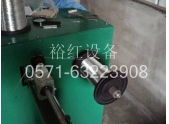


阳极氧化的电压一时间曲线大致可以分为三段
The voltage curve of anodization can be roughly divided into three sections.
靠前段:无孔层形成通电开始的几至十几秒时间内,电压随时间急剧上升至较大值,该值称为临界电压(或形成电压)。说明在阳极上形成了连续的、无孔的薄膜层(阻挡层)。此膜具有较高的电阻,因此随着膜层的加厚,电阻加大,槽电压急剧直线上升。无孔层的出现阻碍了膜层的继续加厚,其厚度与形成电压成正比,与氧化膜在电解液中的溶解速度成反比。在普通硫酸阳极氧化时,采用高频氧化电源13~18V槽电压,则无孔层厚度约为0.Ol~0.Ol5μm。该段的特点是氧化膜的生成速度远大于溶解速度。临界电压受电解液温度的影响很大,温度高,电解液对膜层的溶解作用强,无孔层薄,临界电压较低。
The first section: the voltage rises sharply to the maximum with time, which is called the critical voltage (or the voltage) in a few to ten seconds of the starting of the electrified layer. A continuous, non porous film layer (barrier) is formed on the anode. The film has a higher resistance, so as the film thickens, the resistance increases, and the tank voltage rises sharply. The presence of a non porous layer hinders the continuous thickening of the film, which is directly proportional to the formation voltage and inversely proportional to the dissolution rate of the oxide film in the electrolyte. In normal sulfuric acid anodizing, the thickness of the non porous layer is about 0.Ol to 0.Ol5 0.Ol5 m when the frequency of the high frequency oxidation power supply is 13 ~ 18V. The characteristic of this section is that the formation rate of oxide film is much larger than that of dissolution. The critical voltage is greatly affected by the temperature of the electrolyte, the temperature is high, the electrolyte has strong dissolution effect on the film, the thin layer has no pore, and the critical voltage is low.
第二段:膜孔的出现阳极电位达到较高值以后,开始下降,其下降幅度为较大值的10%~15%。这是由于电解液对膜层的溶解作用,使氧化膜较薄的局部产生孔穴,电阻下降,电压也随之下降。氧化膜有了孔隙之后,电化学反应可继续进行,氧化膜继续生长。
The second paragraph: after the anodic potential reaches the highest value, the decrease of the membrane hole is 10% to 15% of the maximum value. This is due to the dissolution of the electrolyte on the film, resulting in holes in the thinnest part of the oxide film, and the resistance decreases, and the voltage drops. After the oxide film has pores, the electrochemical reaction can continue and the oxide film continues to grow.
第三段:多孔层的增厚此段的特征是氧化时间大约20s后,电压开始趋于平稳。此时,阻挡层生成速度与溶解速度达到平衡,其厚度保持不变,但氧化反应并未停止,氧化膜的生成与溶解仍在每个孔穴的底部继续进行,使孔穴底部向金属内部移动,随着时间的延长,孔穴加深形成孔隙和孔壁。由于孔隙内电解液的存在,导电离子便可在此畅通无阻,因此在多孔层的建立过程中,电阻值的变化并不大,电压也就无明显的变化,反映在特性曲线上是平稳段。多孔层的厚度取决于工艺条件,主要因素为温度。在阳极氧化过程中,由于各种因素的影响,使溶液温度不断提高,对膜层的腐蚀作用也随之加大,不仅孔底,也使孔口处膜层及外表面膜层的腐蚀速度加大,因此多孔层厚度增长变慢。当孔口膜层的腐蚀速度与孔底处的成膜速度相等时,多孔层的厚度就不会再继续增加,该平衡到来的时间越长,则氧化膜越厚。
The third stage: thickening of the porous layer is characterized by a gradual stabilization of the voltage at about 20s. At this time, the formation velocity of the barrier layer is balanced with the dissolution rate, and its thickness remains unchanged, but the oxidation reaction does not stop. The formation and dissolution of the oxide film continue to be carried out at the bottom of each hole, making the bottom of the hole moving to the inside of the metal, and with the prolongation of time, the hole and the hole are formed to form pore and hole wall. Because of the existence of the electrolyte in the pores, the conductive ions can be unimpeded here, so the change of the resistance value is not significant during the establishment of the porous layer, and the voltage has no obvious change, which is reflected on the characteristic curve as a stationary phase. The thickness of porous layer depends on the technological conditions, and the main factor is temperature. In the process of anodic oxidation, the corrosion of the film is increased because of the influence of various factors, and the corrosion of the film is increased. The corrosion rate of the diaphragm and the surface film layer is increased by the hole bottom, so the thickness of the porous layer increases slowly. The thickness of the porous layer will not continue to increase when the corrosion rate of the pore layer is equal to the velocity of the film forming at the bottom of the hole. The longer the arrival time of the balance, the thicker the oxide film is.